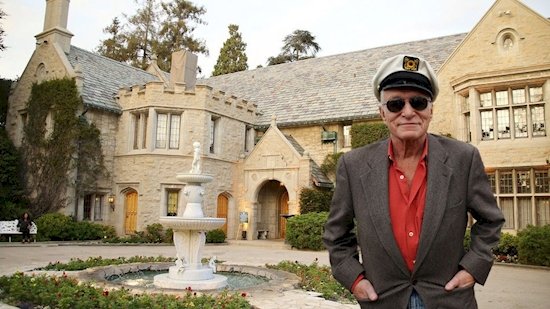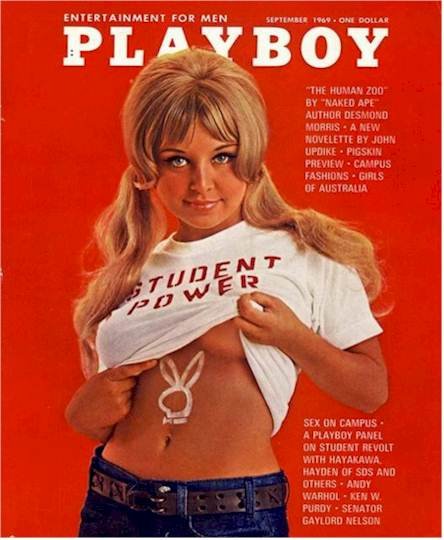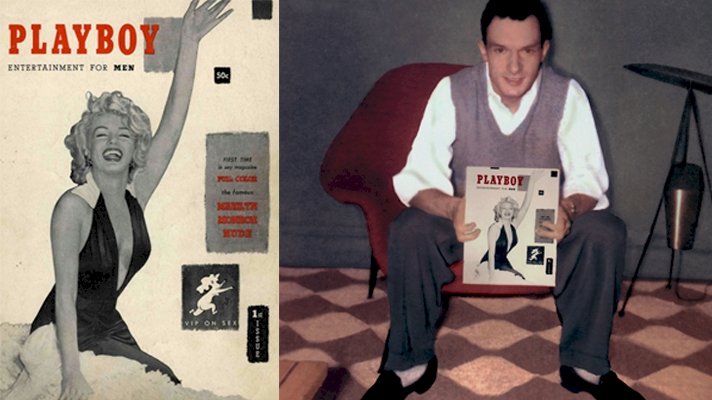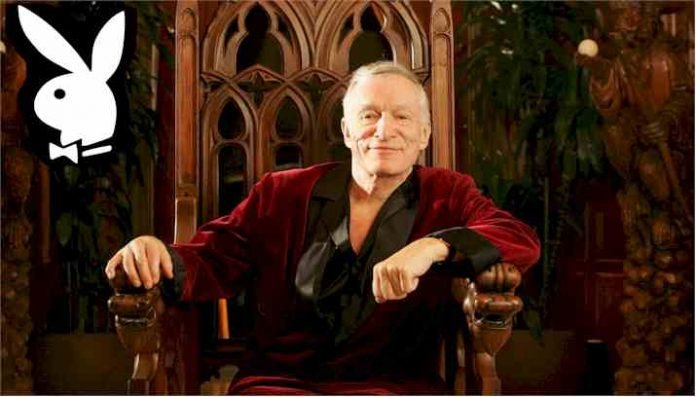The History of the Playboy Logo and Hugh Hefner.
The Playboy logo is one of the most iconic logos in the world, recognizable everywhere as a symbol of prestige, sexiness, and a little bit of mystique. How exactly, though, did the world’s most premier adult magazine end up choosing a rabbit in a bow-tie as their logo? For that matter, how did the world’s most famous playboy, Hugh Hefner, end up starting the magazine to begin with? Turns out, it’s a fascinating story.
The History of Playboy Magazine

In 1951, Hugh Hefner was working as a copywriter for Esquire, a job he would soon quit after being denied a $5 raise. Soon after this, Hefner would go on to start the magazine that would later make him wealthy. Hugh Hefner, though, was certainly not always wealthy. Hefner, now the embodiment of riches and luxury, was only able to start Playboy thanks to a $1,000 loan from his mother. It didn’t take long though for this small investment to pay dividends. The very first issue of Playboy was published in December of 1953 and featured a centerfold nude image of none other than Marilyn Monroe. The magazine was a near-instant success, with the first edition selling all of its near 54,000 copies in just a few weeks.
Just a few months later, the novel that would reach international fame, Fahrenheit 451, was serialized in the March, April, and May of 1954 issues. This trend of featuring high-profile names and works such as Marylin Monroe and Fahrenheit 451 is one that Playboy would continue from that point forward. Women who would go on to pose for the magazine would include celebrity actresses such as Farrah Fawcett and Margot Kidder, sports stars such as Amy Acuff and Amanda Beard, and musicians such as Samantha Fox and Debbie Gibson, just to name a few. The magazine would also continue to publish high-profile interviews, serialized novels, and original comics.
Today, Playboy has sold a whopping 3 million copies in the USA and 4.5 million copies worldwide, amassing Hugh Hefner a net worth of $200,000,000 and though his adventurous lifestyle has slowed considerably in his old age (he is now 90 years old) his name is still synonymous with the playboy lifestyle.
The History of the Playboy Mansion
The Playboy Mansion is located In Holmby Hills, Los Angeles, California, near Beverly Hills, the mansion became famous during the 1960s when the media began to cover the lavish parties thrown by Hefner.
The mansion has 22 rooms with a theater room with a built-in pipe organ, a game room, three zoo/aviary buildings, a tennis court, a basketball court, a waterfall, and a swimming pool area, a basement gym with sauna below the bathhouse and much more.
Interesting facts about the Playboy Mansion.

It was designed by Arthur R. Kelly in 1927.
- Hugh bought the mansion for $1.1 million in 1971
- The mansion has a staff of around 70 people including butlers, chefs, groundskeepers, maintenance, security, and zookeepers.
- In January 2016 the Playboy Mansion went up for sale with the asking price of $200 million with the terms that Hefner could continue
to rent the mansion for the rest of his life. In August 2016 the Playboy Mansion was bought for $100 million by Daren Metropoulos, the co-owner of Hostess Brands. - Every Sunday Hefner has movie nights for special guests and Playmates.
He has over 4,000 movies that are organized
atop the spiraling staircase of his bedroom.
All told, the history of Playboy has been one of fame and success, but what about that of its ever-recognizable logo?
The History of the Playboy Logo
 Clean, simple, and yet entirely unique, the Playboy logos widespread reorganizability has no doubt played a role in the international success of the magazine. While Hugh Hefner was essential in creating Playboy, he was not actually the one who created the iconic logo. That distinction goes to designer Art Paul. Mr. Paul sketched out the logo for use in the second issue of Playboy. Since that second issue, the logo has not once been changed from the original design. This in itself is a remarkable fact considering how often companies redesign their logos these days and is a testament to the effectiveness of the original logo’s design.
Clean, simple, and yet entirely unique, the Playboy logos widespread reorganizability has no doubt played a role in the international success of the magazine. While Hugh Hefner was essential in creating Playboy, he was not actually the one who created the iconic logo. That distinction goes to designer Art Paul. Mr. Paul sketched out the logo for use in the second issue of Playboy. Since that second issue, the logo has not once been changed from the original design. This in itself is a remarkable fact considering how often companies redesign their logos these days and is a testament to the effectiveness of the original logo’s design.
Features of the Playboy Logo
 In designing a logo for Playboy Art Paul’s original vision was something that had a “humorous sexual connotation” as well as something that was “frisky and playful”. Speaking on why a rabbit was chosen as the magazine’s logo, Hugh Hefner said that, “The rabbit, the bunny, in America has a sexual meaning; and I chose it because it’s a fresh animal, shy, vivacious, jumping – sexy. First, it smells you then it escapes, then it comes back, and you feel like caressing it, playing with it. A girl looks a lot like a bunny, playful and joking. If you look at the girl we made popular: the Playmate of the Month. She is never sophisticated, a girl you cannot really have. She is a young, healthy, simple girl – the girl next door . . . we are not interested in the mysterious, difficult woman, the femme fatale, who wears elegant underwear, with lace, and she is sad, and somehow mentally filthy. The Playboy girl has no lace, no underwear, she is naked, well-washed with soap and water, and she is happy.”
In designing a logo for Playboy Art Paul’s original vision was something that had a “humorous sexual connotation” as well as something that was “frisky and playful”. Speaking on why a rabbit was chosen as the magazine’s logo, Hugh Hefner said that, “The rabbit, the bunny, in America has a sexual meaning; and I chose it because it’s a fresh animal, shy, vivacious, jumping – sexy. First, it smells you then it escapes, then it comes back, and you feel like caressing it, playing with it. A girl looks a lot like a bunny, playful and joking. If you look at the girl we made popular: the Playmate of the Month. She is never sophisticated, a girl you cannot really have. She is a young, healthy, simple girl – the girl next door . . . we are not interested in the mysterious, difficult woman, the femme fatale, who wears elegant underwear, with lace, and she is sad, and somehow mentally filthy. The Playboy girl has no lace, no underwear, she is naked, well-washed with soap and water, and she is happy.”
As for the colors used in the Playboy logo, a solid black tone conveys luxury, professionalism, and, class. Much like a good suit, there was never a need to dress up the Playboy logo in elaborate colors when solid black so effectively conveys the magazine’s image.
Looking For a Logo Designer?
Thousands of businesses have trusted LogoMyWay with their logo design. We have thousands of logo designers ready to work on your new logo.
The popularity of the Playboy Logo
Throughout the history of the Playboy logo, the iconic rabbit has enjoyed a large degree of popularity. For one, the image has been featured on every cover of the Playboy magazines that have been published. While you might not notice the logo on the first glance at any given Playboy magazine, it is indeed there. An ongoing joke for the Playboy staff was to hide the logo somewhere on the cover of each magazine, and it was a tradition that stuck.
 Along with appearing on every cover of one of the world’s best-selling magazines, the Playboy logo has made appearances on a variety of other merchandise as well. In fact, selling products that featured the Playboy logo has and continues to be a major source of income for the company. The unmistakable black rabbit could be found on everything from lighters to t-shirts, serving as a testament to just how much good a great logo can do for a business. In the 1950s the Playboy logo was even adopted as the military aircraft insignia for the Navy VX-4 fighter-evaluation squadron.
Along with appearing on every cover of one of the world’s best-selling magazines, the Playboy logo has made appearances on a variety of other merchandise as well. In fact, selling products that featured the Playboy logo has and continues to be a major source of income for the company. The unmistakable black rabbit could be found on everything from lighters to t-shirts, serving as a testament to just how much good a great logo can do for a business. In the 1950s the Playboy logo was even adopted as the military aircraft insignia for the Navy VX-4 fighter-evaluation squadron.
Not limited to a for-profit enterprise, the Playboy logo made its mark on charitable causes as well. In the annual “Rock the Rabbit” music news feature, fashion designers would create t-shirts for famous bands based on the logo. The bands were then photographed wearing their specific t-shirts, and these photos were featured in the magazine’s March edition. After the issues were published, the t-shirts were sold at auction and the money was donated to AIDS at LIFEbeat: The Music Industry Fights AIDS.
Next to Bugs Bunny, the Playboy bunny may very well be the world’s most famous rabbit, and the impact that the logo has made on the magazine’s success is nothing short of substantial. It’s a classic logo with a great history and is certainly one whose effectiveness is worth imitating.
The First Edition of the Playboy Magazine

In December 1953, Hugh Hefner published the very first edition of Playboy. However, the magazine’s first edition didn’t have the date of the publication on the cover since Hugh Hefner was still unsure whether or not the magazine would be successful enough to warrant future editions. This was an understandable concern given that Hefner was selling copies of the first edition out of the office he had set up in his home’s kitchen. However, Hugh Hefner’s concern about the magazine not being successful turned out to be all for naught, as the first edition of Playboy flew off the magazine stand shelves. Within a matter of weeks, the magazine had sold over 50,000 copies.
A big part of the first edition’s success is no doubt attributable to Playboy’s very first cover girl, Marylin Monroe. Interestingly enough, though, Monroe never actually signed a contract to appear in the magazine.
Before Marylin Monroe became a household name, she was a struggling actress in desperate need of cash. To earn a little money, she posed nude in 1949 for photographer Tom Kelley. Monroe was paid $50 for the photoshoot, and Kelley sold the photos to a calendar company called Western Lithograph Company.
Less than a year later, though, Marylin Monroe’s acting career took off after she appeared in the films “Asphalt Jungle” and “All About Eve”. By 1953, Monroe was one of the most famous actresses in all of Hollywood.
However, Western Lithograph Company stilled owned the rights to the photos that Monroe had taken in 1949, and Hugh Hefner purchased the rights to those photos for $500. The photos were used as the first edition’s centerfold, and Marylin Monroe was named “Sweetheart of the Month”.
Following the magazine’s publication, Marylin Monroe decided to meet any controversy that might ensue head-on by agreeing to an interview where she explained that the photos had been taken at a time in her life when she was desperate for money. Marylin Monroe’s career never took a hit from the photos in the first edition of Playboy, and she and Hugh Hefner went on to become close acquaintances.
In addition to the Marylin Monroe photos, the first edition of Playboy also featured a number of nude photographs of far less famous women, several men’s lifestyle articles, a fictional story about detective Sherlock Holmes from Sir Arthur Conan Doyle, and more.
At the time, the first edition of Playboy was a truly groundbreaking entrance into the market, bringing controversial, sexual topics and photographs into center stage for the first time in American history. This bold angle had the potential to either make or break Playboy right from the start and Hugh Hefner was certainly aware that the first magazine was an “all or nothing” business decision.
As history now shows, though, the first edition of Playboy was published at the perfect time, and Hugh Hefner was able to both ride and help usher in a wave of sexual liberation that would make Playboy one of the most successful publications of all time.
A Biography of Hugh Hefner
It’s impossible to fully detail the rich history of Playboy magazine without further discussing the life of its iconic founder, Hugh Hefner.
Hugh Hefner was born on April 9, 1926, in Chicago, Illinois. There, he was raised along with his younger brother by his parents Glenn and Grace Hefner, who were reportedly fairly strict Methodists.
At an early age, Hugh Hefner demonstrated an exceptional IQ of 152, but his genius-level intelligence only translated into modest academic success. It wasn’t until Hefner shifted into writing and journalism that he began to excel.
In high school, Hugh Hefner founded a school newspaper as well as his own comic series he called School Daze. Both publications were a success, and Hefner realized that he had a talent for producing publications that people enjoyed reading.
However, by the time Hugh Hefner graduated high school, people were far more concerned with the war than they were entertainment publications, and Hugh Hefner himself answered the call of duty by enlisting as a noncombatant in the U.S. Army toward the end of World War Two. Once he was discharged in 1946 after two years of service, though, Hefner returned home to attend the University of Illinois at Urbana-Champaign where he earned a bachelor’s degree in psychology.
Within a couple years of graduating, Hugh Hefner married Millie Williams and began working as a copywriter for Esquire. It was a prestigious position, but it was one that Hugh Hefner decided to abandon after he was denied a $5 raise.
Unemployed, Hugh Hefner decided that the next step in his career path would be to return to the roots he established in high school and start his own publication. After raising $8000 from investors, Hugh Hefner founded Playboy magazine.
Hugh Hefner put together the first issue of Playboy in his home and published it in December 1953 using a nude photo of Marylin Monroe that he had purchased the rights to. The magazine was a near-instant success.
During the same time period that his magazine was taking off, though, Hugh Hefner was also plagued with problems at home, and he and his wife were divorced in 1959. A newly single man, Hugh Hefner began to adopt the lifestyle that Playboy was built around. Now in the public spotlight, his luxurious lifestyle and romantic pursuits became just as much a part of the magazine’s image as the publication itself.
For the rest of his life, Hugh Hefner surrounded himself with beautiful women, eventually becoming somewhat infamous for marrying and divorcing women that were many years younger than he was. However, Hugh Hefner also used his wealth and platform to promote a number of charitable causes, including the restoration of classic films and donations to various cinema courses.
Hugh Hefner lived out his final days in the Playboy Mansion before passing away on September 27, 2017, at the age of 91, and on September 30, he was laid to rest next to Marylin Monroe in the Westwood Memorial Park in Los Angeles, California.







